Soil Recovery Assessment after Timber Harvesting Based on the Sustainable Forest Operation (SFO) Perspective in Iranian Temperate Forests
Abstract
1. Introduction
2. Materials and Methods
2.1. Site Description
2.2. Experimental Design
2.3. Measurements and Laboratory Analysis
2.4. Statistical Analyses
3. Results
3.1. Physical Properties of the Soil
3.2. The Chemical and Biological Properties of the Soil
3.3. Principal Component Analysis (PCA)
4. Discussion
5. Conclusions
Author Contributions
Funding
Acknowledgments
Conflicts of Interest
References
- Heinimann, H.R. Forest operations engineering and management—The ways behind and ahead of a scientific discipline. Croat. J. For. Eng. 2007, 28, 107–121. [Google Scholar]
- Marchi, E.; Picchio, R.; Spinelli, R.; Verani, S.; Venanzi, R.; Certini, G. Environmental impact assessment of different logging methods in pine forests thinning. Ecol. Eng. 2014, 70, 429–436. [Google Scholar] [CrossRef]
- Marchi, E.; Chung, W.; Visser, R.; Abbas, D.; Nordfjell, T.; Mederski, P.S.; McEwan, A.; Brink, M.; Laschi, A. Sustainable Forest Operations (SFO): A new paradigm in a changing world and climate. Sci. Total Environ. 2018, 634, 1385–1397. [Google Scholar] [CrossRef] [PubMed]
- Riala, M.; Athanassiadis, D.; la Hera, P.; Rodriguez, J. Development Potential of Inventions in Forest Biomass Harvesting. D 6.3. INFRES Project Report. 2015. Available online: http://www.forestenergy.org/observer:get_page/observer/action/details/itemid/706 (accessed on 28 March 2018).
- Venanzi, R.; Picchio, R.; Piovesan, G. Silvicultural and logging impact on soil characteristics in Chestnut (Castanea sativa Mill.) Mediterranean coppice. Ecol. Eng. 2016, 92, 82–89. [Google Scholar] [CrossRef]
- Dominati, E.; Patterson, M.; Mackay, A. A framework for classifying and quantifying the natural capital and ecosystem services of soils. Ecol. Econ. 2010, 69, 1858–1868. [Google Scholar] [CrossRef]
- Picchio, R.; Tavankar, F.; Nikooy, M.; Pignatti, G.; Venanzi, R.; Lo Monaco, A. Morphology, growth and architecture response of beech (Fagus orientalis Lipsky) and maple tree (Acer velutinum Boiss.) seedlings to soil compaction stress caused by mechanized logging operations. Forests 2019, 10, 771. [Google Scholar] [CrossRef]
- Picchio, R.; Mercurio, R.; Venanzi, R.; Gratani, L.; Giallonardo, T.; Lo Monaco, A.; Frattaroli, A.R. Strip clear-cutting application and logging typologies for renaturalization of pine afforestation—A case study. Forests 2018, 9, 366. [Google Scholar] [CrossRef]
- Picchio, R.; Venanzi, R.; Tavankar, F.; Luchenti, I.; Iranparast Bodaghi, A.; Latterini, F.; Nikooy, M.; Di Marzio, N.; Naghdi, R. Changes in soil parameters of forests after windstorms and timber extraction. Eur. J. For. Res. 2019, 138, 875–888. [Google Scholar] [CrossRef]
- Jourgholami, M.; Ghassemi, T.; Labelle, E.R. Soil physio-chemical and biological indicators to evaluate the restoration of compacted soil following reforestation. Ecol. Indic. 2019, 101, 102–110. [Google Scholar] [CrossRef]
- Marchi, E.; Picchio, R.; Mederski, P.S.; Vusić, D.; Perugini, M.; Venanzi, R. Impact of silvicultural treatment and forest operation on soil and regeneration in Mediterranean Turkey oak (Quercus cerris L.) coppice with standards. Ecol. Eng. 2016, 95, 475–484. [Google Scholar] [CrossRef]
- Klaes, B.; Struck, J.; Schneider, R.; Schüler, G. Middle-term effects after timber harvesting with heavy machinery on a fine-textured forest soil. Eur. J. For. Res. 2016, 135, 1083–1095. [Google Scholar] [CrossRef]
- Tavankar, F.; Bonyad, A.E.; Nikooy, M.; Picchio, R.; Venanzi, R.; Calienno, L. Damages to soil and tree species by cable-skidding in Caspian forests of Iran. For. Syst. 2017, 26, 1–9. [Google Scholar] [CrossRef]
- Matthews, D.M. Cost Control in the Logging Industry; McGraw-Hill: New York, NY, USA, 1942; p. 374. [Google Scholar]
- Poltorak, B.J.; Labelle, E.R.; Jaeger, D. Soil displacement during ground-based mechanized forest operations using mixed-wood brush mats. Soil Till. Res. 2018, 179, 96–104. [Google Scholar] [CrossRef]
- Flores Fernández, J.L.; Rubin, L.; Hartmann, P.; Puhlmann, H.; von Wilpert, K. Initial recovery of soil structure of a compacted forest soil can be enhanced by technical treatments and planting. For. Ecol. Manag. 2019, 431, 54–62. [Google Scholar] [CrossRef]
- Jourgholami, M.; Labelle, E.R.; Feghhi, J. Efficacy of leaf litter mulch to mitigate runoff and sediment yield following mechanized operations in the Hyrcanian mixed forests. J. Soils Sediments 2019, 19, 2076–2088. [Google Scholar] [CrossRef]
- Cambi, M.; Grigolato, S.; Neri, F.; Picchio, R.; Marchi, E. Effects of forwarder operation on soil physical characteristics: A case study in the Italian Alps. Croat. J. For. Eng. 2016, 37, 233–239. [Google Scholar]
- Picchio, R.; Spina, R.; Calienno, L.; Venanzi, R.; Lo Monaco, A. Forest operations for implementing silvicultural treatments for multiple purposes. Ital. J. Agron. 2016, 11, 156–161. [Google Scholar]
- Venanzi, R.; Picchio, R.; Grigolato, S.; Latterini, F. Soil and forest regeneration after different extraction methods in coppice forests. For. Ecol. Manag. 2019, 454, 117666. [Google Scholar] [CrossRef]
- Flores Fernández, J.L.; Hartmann, P.; Schäffer, J.; Puhlmann, H.; von Wilpert, K. Initial recovery of compacted soil planting and technical treatments decrease CO2 concentrations in soil and promote root growth. Ann. For. Sci. 2017, 74, 73. [Google Scholar] [CrossRef]
- Ampoorter, E.; Goris, R.; Cornelis, W.M.; Verheyen, K. Impact of mechanized logging on compaction status of sandy forest soils. For. Ecol. Manag. 2007, 241, 162–174. [Google Scholar] [CrossRef]
- Makineci, E.; Demir, M.; Comez, A.; Yilmaz, E. Chemical characteristics of the surface soil, herbaceous cover and organic layer of a compacted skid road in a fir (Abies bornmulleriana Mattf.) forest. Transport. Res. Part D 2007, 12, 453–459. [Google Scholar] [CrossRef]
- Bottinelli, N.; Capowiez, Y.; Ranger, J. Slow recovery of earthworm populations after heavy traffic in two forest soils in northern France. Appl. Soil Ecol. 2014, 73, 130–133. [Google Scholar] [CrossRef]
- Schweier, J.; Blagojević, B.; Venanzi, R.; Latterini, F.; Picchio, R. Sustainability assessment of alternative strip clear cutting operations for wood chip production in renaturalization management of pine stands. Energies 2019, 12, 3306. [Google Scholar] [CrossRef]
- Brevik, E.; Fenton, T.; Moran, L. Effect of soil compaction on organic carbon amounts and distribution, South-Central Iowa. Environ. Pollut. 2002, 116, S137–S141. [Google Scholar] [CrossRef]
- Sohrabi, H.; Jourgholami, M.; Tavankar, F.; Venanzi, R.; Picchio, R. Post-harvest evaluation of soil physical properties and natural regeneration growth in steep-slope terrains. Forests 2019, 10, 1034. [Google Scholar] [CrossRef]
- Makineci, E.; Demir, M.; Comez, A.; Yilmaz, E. Effects of timber skidding on chemical characteristics of herbaceous cover, forest floor and topsoil on skidroad in an oak (Quercus petrea L.) forest. J. Terramech. 2007, 44, 423–428. [Google Scholar] [CrossRef]
- Goutal, N.; Renault, P.; Ranger, J. Forwarder traffic impacted over at least four years soil air composition of two forest soils in northeast France. Geoderma 2013, 193, 29–40. [Google Scholar] [CrossRef]
- Hartmann, M.; Niklaus, P.A.; Zimmermann, S.; Schmutz, S.; Kremer, J.; Abarenkov, K.; Lüscher, P.; Widmer, F.; Frey, B. Resistance and resilience of the forest soil microbiome to logging-associated compaction. ISME J. 2014, 8, 226. [Google Scholar] [CrossRef]
- Epron, D.; Plain, C.; Ndiaye, F.K.; Bonnaud, P.; Pasquier, C.; Ranger, J. Effects of compaction by heavy machine traffic on soil fluxes of methane and carbon dioxide in a temperate broadleaved forest. For. Ecol. Manag. 2016, 382, 1–9. [Google Scholar] [CrossRef]
- Jourgholami, M.; Soltanpour, S.; Etehadi Abari, M.; Zenner, E.K. Influence of slope on physical soil disturbance due to farm tractor forwarding in a Hyrcanian forest of northern Iran. iForest 2014, 7, 342–348. [Google Scholar] [CrossRef]
- Cambi, M.; Hoshika, Y.; Mariotti, B.; Paoletti, E.; Picchio, R.; Venanzi, R.; Marchi, E. Compaction by a forest machine affects soil quality and Quercus robur L. seedling performance in an experimental field. For. Ecol. Manag. 2017, 384, 406–414. [Google Scholar] [CrossRef]
- Picchio, R.; Latterini, F.; Mederski, P.S.; Venanzi, R.; Karaszewski, Z.; Bembenek, M.; Croce, M. Comparing accuracy of three methods based on the gis environment for determining winching areas. Electronics 2019, 8, 53. [Google Scholar] [CrossRef]
- Najafi, A.; Solgi, A.; Sadeghi, S.H. Soil disturbance following four wheel rubber skidder logging on the steep trail in the north mountainous forest of Iran. Soil Till. Res. 2009, 103, 165–169. [Google Scholar] [CrossRef]
- Jaafari, A.; Najafi, A.; Zenner, E.K. Ground-based skidder traffic changes chemical soil properties in a mountainous Oriental beech (Fagus orientalis Lipsky) forest in Iran. J. Terramech. 2014, 55, 39–46. [Google Scholar] [CrossRef]
- Jourgholami, M.; Labelle, E.R.; Feghhi, J. Response of Runoff and Sediment on Skid Trails of Varying Gradient and Traffic Intensity over a Two-Year Period. Forests 2017, 8, 472. [Google Scholar] [CrossRef]
- Kozlowski, T.T. Soil compaction and growth of woody plants. Scand. J. For. Res. 1999, 14, 596–619. [Google Scholar] [CrossRef]
- DeArmond, D.; Emmert, F.; Lima, A.J.N.; Higuchi, N. Impacts of soil compaction persist 30 years after logging operations in the Amazon Basin. Soil Till. Res. 2019, 189, 207–216. [Google Scholar] [CrossRef]
- Dexter, A.R. Amelioration of soil by natural processes. Soil Till. Res. 1991, 20, 87–100. [Google Scholar] [CrossRef]
- Meyer, C.; Lüscher, P.; Schulin, R. Recovery of forest soil from compaction in skid tracks planted with black alder (Alnus glutinosa (L.) Gaertn.). Soil Till. Res. 2014, 143, 7–16. [Google Scholar] [CrossRef]
- Lal, R. Effects of macrofauna on soil properties in tropical ecosystems. Agric. Ecosyst. Environ. 1988, 24, 101–116. [Google Scholar] [CrossRef]
- Fründ, H.C.; Averdiek, A. Soil aeration and soil water tension in skidding trails during three years after trafficking. For. Ecol. Manag. 2016, 380, 224–231. [Google Scholar] [CrossRef]
- Jourgholami, M.; Etehadi Abari, M. Effectiveness of sawdust and straw mulching on postharvest runoff and soil erosion of a skid trail in a mixed forest. Ecol. Eng. 2017, 109, 1–9. [Google Scholar] [CrossRef]
- Mace, A.C., Jr. Recovery of Forest Soils from Compaction by Rubber-Tired Skidders; School of Forestry, University of Minnesota: St. Paul, MN, USA, 1971; Volume 226, p. 7688. [Google Scholar]
- Reisinger, T.W.; Pope, P.E.; Hammond, S.C. Natural recovery of compacted soils in an upland hardwood forest in Indiana. North. J. Appl. For. 1992, 9, 138–141. [Google Scholar] [CrossRef]
- Zenner, E.K.; Fauskee, J.T.; Berger, A.L.; Puettmann, K.J. Impacts of skidding traffic intensity on soil disturbance, soil recovery, and aspen regeneration in north central Minnesota. North. J. Appl. For. 2007, 24, 177–183. [Google Scholar] [CrossRef]
- Mohieddinne, H.; Brasseur, B.; Spicher, F.; Gallet-Moron, E.; Buridant, J.; Kobaissi, A.; Horen, H. Physical recovery of forest soil after compaction by heavy machines, revealed by penetration resistance over multiple decades. For. Ecol. Manag. 2019, 449, 117472. [Google Scholar] [CrossRef]
- Rab, M.A. Recovery of soil physical properties from compaction and soil profile disturbance caused by logging of native forest in Victorian Central Highlands, Australia. For. Ecol. Manag. 2004, 191, 329–340. [Google Scholar] [CrossRef]
- Ezzati, S.; Najafi, A.; Rab, M.A.; Zenner, E.K. Recovery of soil bulk density, porosity and rutting from ground skidding over a 20-year period after timber harvesting in Iran. Silva Fenni. 2012, 46, 521–538. [Google Scholar] [CrossRef]
- Jourgholami, M.; Khajavi, S.; Labelle, E.R. Mulching and water diversion structures on skid trails: Response of soil physical properties six years after harvesting. Ecol. Eng. 2018, 123, 1–9. [Google Scholar] [CrossRef]
- Von Wilpert, K.; Schäffer, J. Ecological effects of soil compaction and initial recovery dynamics: A preliminary study. Eur. J. For. Res. 2006, 125, 129–138. [Google Scholar] [CrossRef]
- Mariani, L.; Chang, S.X.; Kabzems, R. Effects of tree harvesting, forest floor removal, and compaction on soil microbial biomass, microbial respiration, and N availability in a boreal aspen forest in British Columbia. Soil Biol. Biochem. 2006, 38, 1734–1744. [Google Scholar] [CrossRef]
- Macedo, M.O.; Resende, A.S.; Garcia, P.C.; Boddey, R.M.; Jantalia, C.P.; Urquiaga, S.; Campello, E.F.C.; Franco, A.A. Changes in soil C and N stocks and nutrient dynamics 13 years after recovery of degraded land using leguminous nitrogen-fixing trees. For. Ecol. Manag. 2008, 255, 1516–1524. [Google Scholar] [CrossRef]
- Hope, G.D. Changes in soil properties, tree growth, and nutrition over a period of 10 years after stump removal and scarification on moderately coarse soils in interior British Columbia. For. Ecol. Manag. 2007, 242, 625–635. [Google Scholar] [CrossRef]
- Li, Q.; Allen, H.L.; Wollum II, A.G. Microbial biomass and bacterial functional diversity in forest soils: Effects of organic matter removal, compaction, and vegetation control. Soil Biol. Biochem. 2004, 36, 571–579. [Google Scholar] [CrossRef]
- Curran, M.; Dubé, S.; Bulmer, C.; Berch, S.; Chapman, B.; Hope, G.; Currie, S.; Courtin, P.; Kranabetter, M. Forest and Range Evaluation Program, Ministry of Forests and Range and Ministry of the Environment; Protocol for Soil Resource Stewardship Monitoring: Victoria, BC, Canada, 2009. [Google Scholar]
- Nugent, C.; Kanali, C.; Owende, P.M.; Nieuwenhuis, M.; Ward, S. Characteristic site disturbance due to harvesting and extraction machinery traffic on sensitive forest sites with peat soils. For. Ecol. Manag. 2003, 180, 85–98. [Google Scholar] [CrossRef]
- Picchio, R.; Neri, F.; Petrini, E.; Verani, S.; Marchi, E.; Certini, G. Machinery-induced soil compaction in thinning two pine stands in central Italy. For. Ecol. Manag. 2012, 285, 38–43. [Google Scholar] [CrossRef]
- Walkley, A.; Black, I.A. An examination of the Degtjareff method for determining soil organic matter, and a proposed modification of the chromic acid titration method. Soil Sci. 1934, 37, 29–38. [Google Scholar] [CrossRef]
- Salehi, A.; Ghorbanzadeh, N.; Kahneh, E. Earthworm biomass and abundance, soil chemical and physical properties under different poplar plantations in the north of Iran. J. For. Sci. 2013, 59, 223–229. [Google Scholar] [CrossRef]
- Kooch, Y.; Zaccone, C.; Lamersdorf, N.P.; Tonon, G. Pit and mound influence on soil features in an Oriental Beech (Fagus orientalis Lipsky) forest. Eur. J. For. Res. 2014, 133, 347–354. [Google Scholar] [CrossRef]
- Tavankar, F.; Majnounian, B.; Bonyad, A.E. Logging damages on forest regeneration and soil compaction using ground-based system (case study: Asalem forest area, Guilan). Water Soil Sci. 2009, 13, 449–456. [Google Scholar]
- Gayoso, J.; Iroume, A. Compaction and soil disturbances from logging in Southern Chile. Ann. Forest Sci. 1991, 48, 63–71. [Google Scholar] [CrossRef]
- Majnounian, B.; Jourgholami, M. Effect of rubber-tired cable skidder on soil compaction in Hyrcanian forest. Croat. J. For. Eng. 2013, 34, 123–135. [Google Scholar]
- Greacen, E.L.; Sands, R. Compaction of forest soils. A review. Soil Res. 1980, 18, 163–189. [Google Scholar] [CrossRef]
- Ampoorter, E.; De Schrijver, A.; Van Nevel, L.; Hermy, M.; Verheyen, K. Impact of mechanized harvesting on compaction of sandy and clayey forest soils: Results of a meta-analysis. Ann. For. Sci. 2012, 69, 533–542. [Google Scholar] [CrossRef]
- Botta, G.F.; Jorajuria, D.; Rosatto, H.; Ferrero, C. Light tractor traffic frequency on soil compaction in the Rolling Pampa region of Argentina. Soil Till. Res. 2006, 86, 9–14. [Google Scholar] [CrossRef]
- Eliasson, L. Effects of forwarder tyre pressure on rut formation and soil compaction. Silva Fenn. 2005, 39, 549. [Google Scholar] [CrossRef]
- Hatchell, G.E.; Ralston, C.W.; Foil, R.R. Soil disturbance in logging. J. For. 1970, 68, 772–775. [Google Scholar]
- Hosseini, S.A.O.; Nasiri, M.; Akbarimehr, M. Skidders traffic assessment on forest soil properties. Int. J. Civ. Eng. 2015, 13, 372–377. [Google Scholar]
- Demir, M.; Makineci, E.; Yilmaz, E. Investigation of timber harvesting impacts on herbaceous cover, forest floor and surface soil properties on skid road in an oak (Quercus petrea L.) stand. Build. Environ. 2007, 42, 1194–1199. [Google Scholar] [CrossRef]
- Demir, M.; Makineci, E.; Comez, A.; Yilmaz, E. Impacts of repeated timber skidding on the chemical properties of topsoil, herbaceous cover and forest floor in an eastern beech (Fagus orientalis Lipsky) stand. J. Environ. Biol. 2010, 31, 477–482. [Google Scholar]
- Jourgholami, M.; Nasirian, A.; Labelle, E. Ecological restoration of compacted soil following the application of different leaf litter mulches on the skid trail over a five-year period. Sustainability 2018, 10, 2148. [Google Scholar] [CrossRef]
- Prescott, C.E.; Grayston, S.J. Tree species influence on microbial communities in litter and soil: Current knowledge and research needs. For. Ecol. Manag. 2013, 309, 19–27. [Google Scholar] [CrossRef]
- Jourgholami, M.; Labelle, E.R. Effects of plot length and soil texture on runoff and sediment yield occurring on machine-trafficked soils in a mixed deciduous forest. Ann. For. Sci. 2020, 77, 19. [Google Scholar] [CrossRef]
- Jourgholami, M.; Fathi, K.; Labelle, E.R. Effects of litter and straw mulch amendments on compacted soil properties and Caucasian alder (Alnus subcordata) growth. New For. 2020, 51, 349–365. [Google Scholar] [CrossRef]
- Ampoorter, E.; De Schrijver, A.; De Frenne, P.; Hermy, M.; Verheyen, K. Experimental assessment of ecological restoration options for compacted forest soils. Ecol. Eng. 2011, 37, 1734–1746. [Google Scholar] [CrossRef]
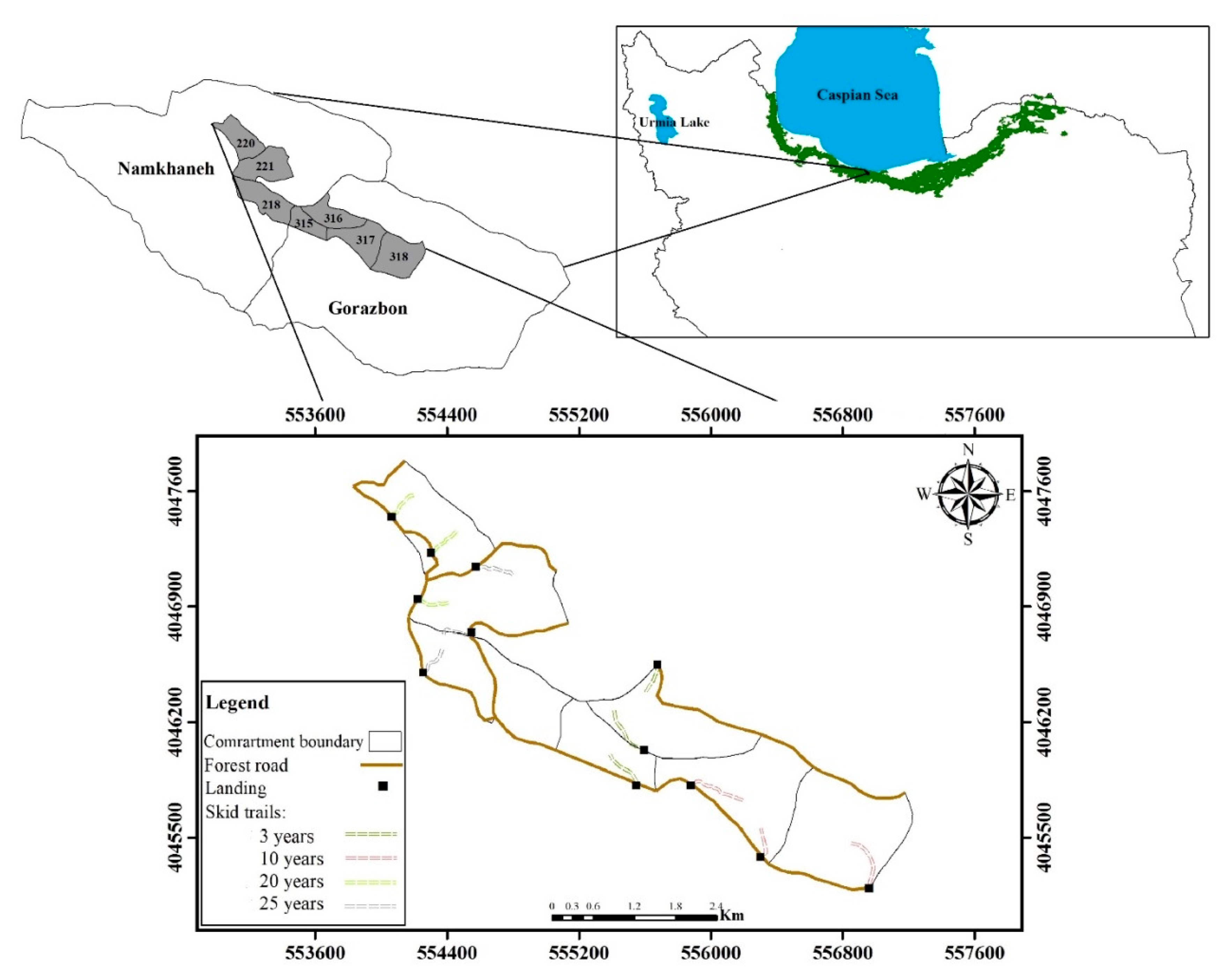
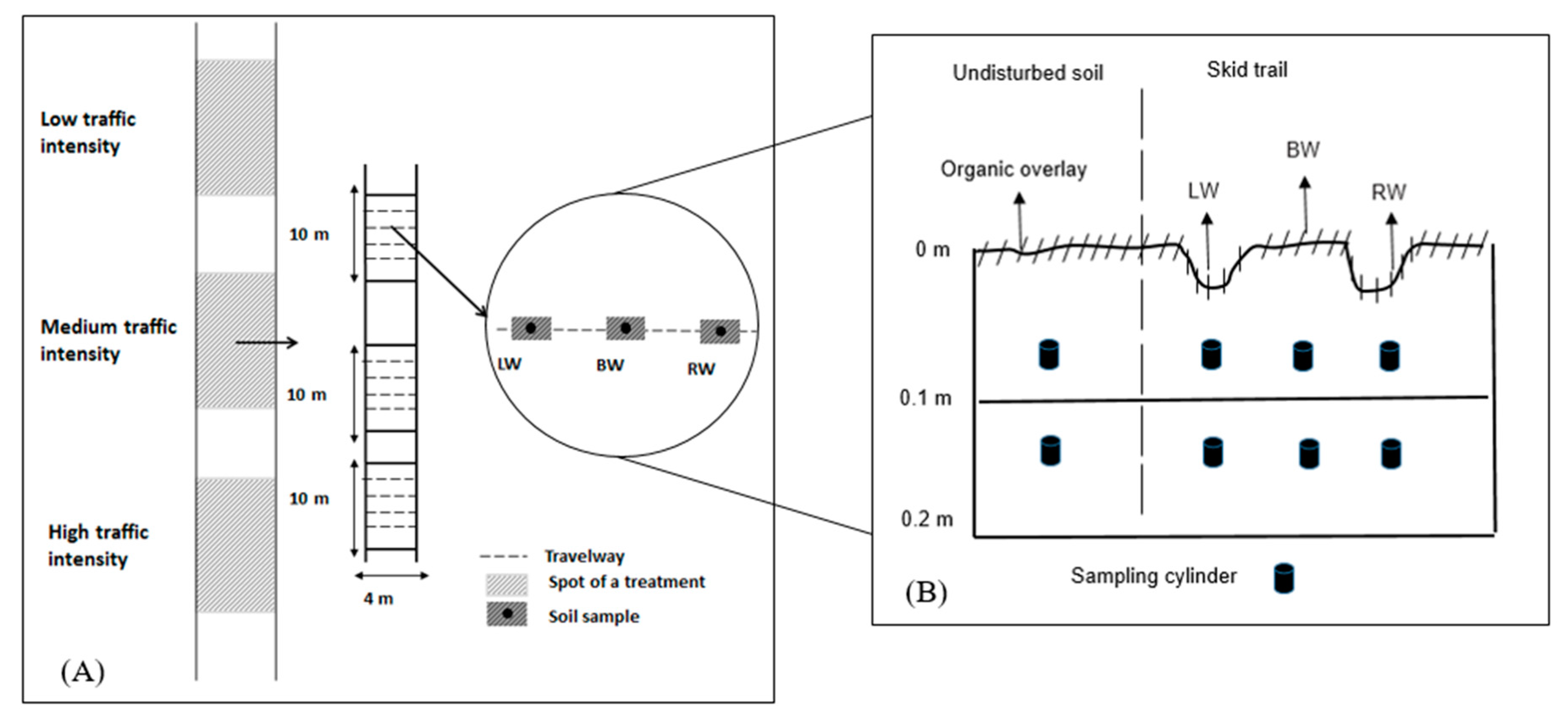
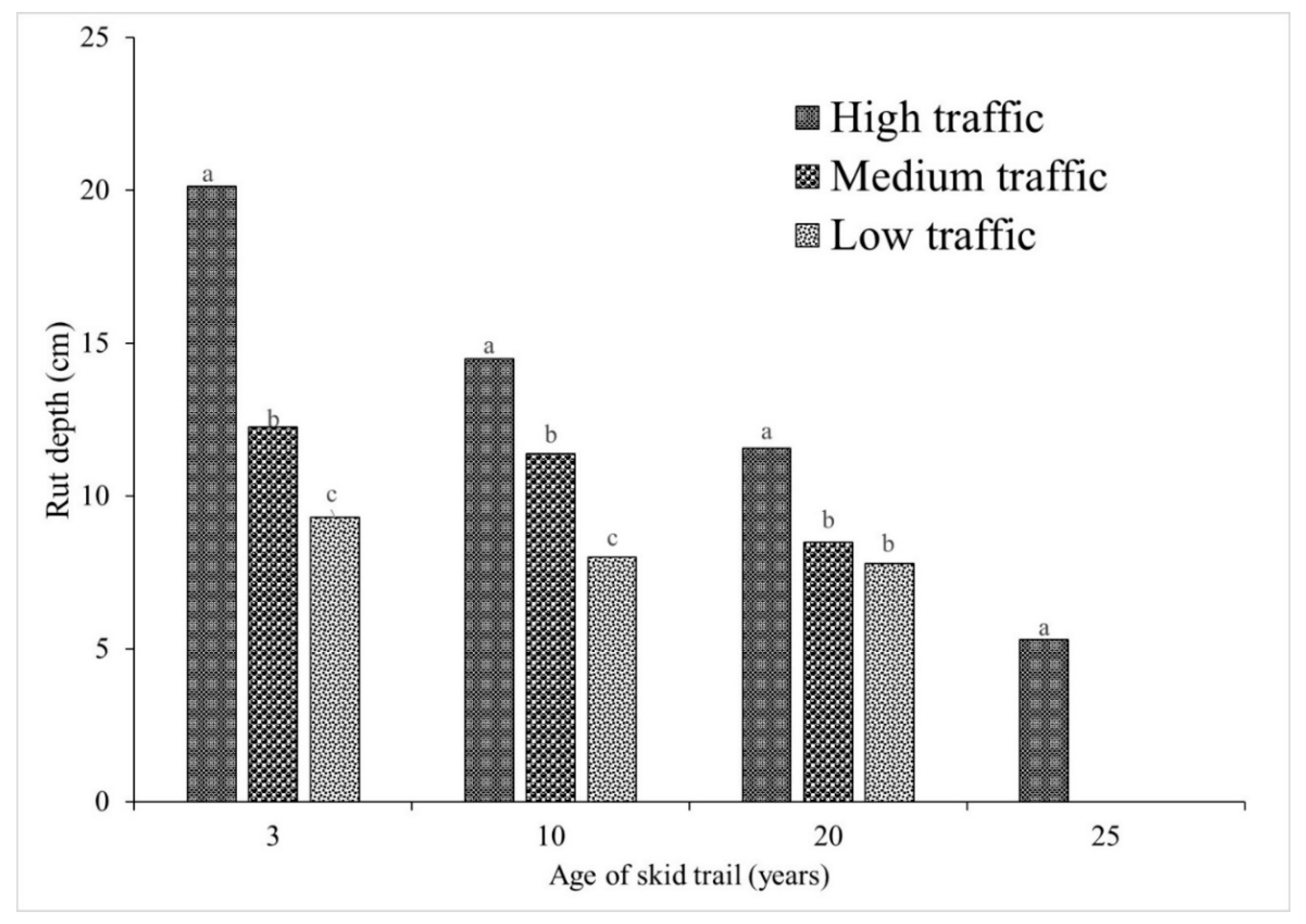
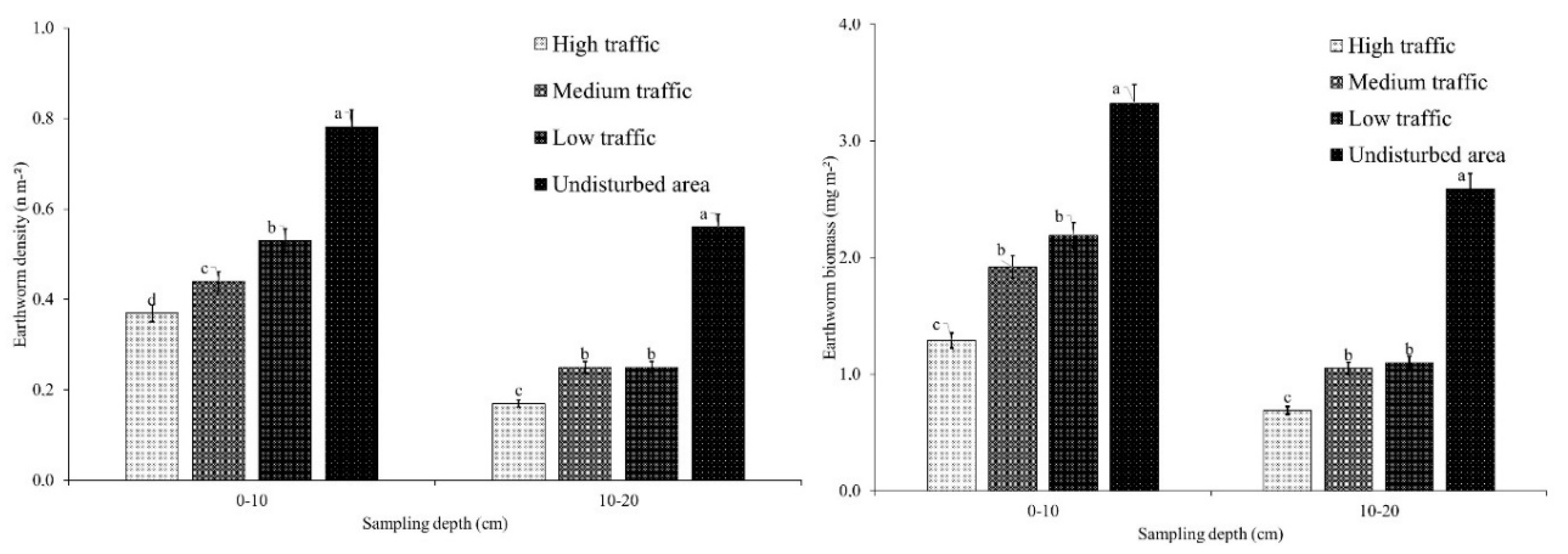
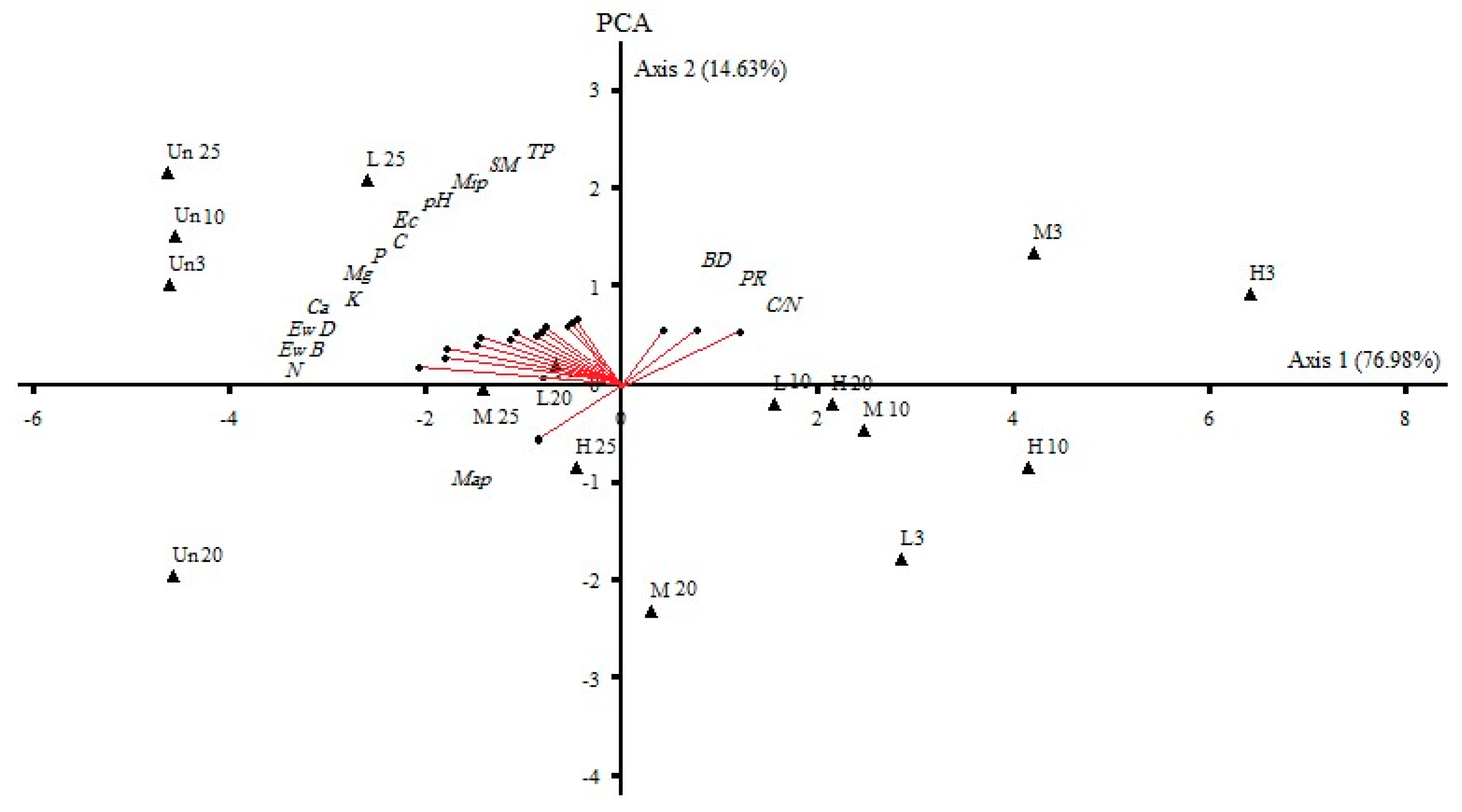
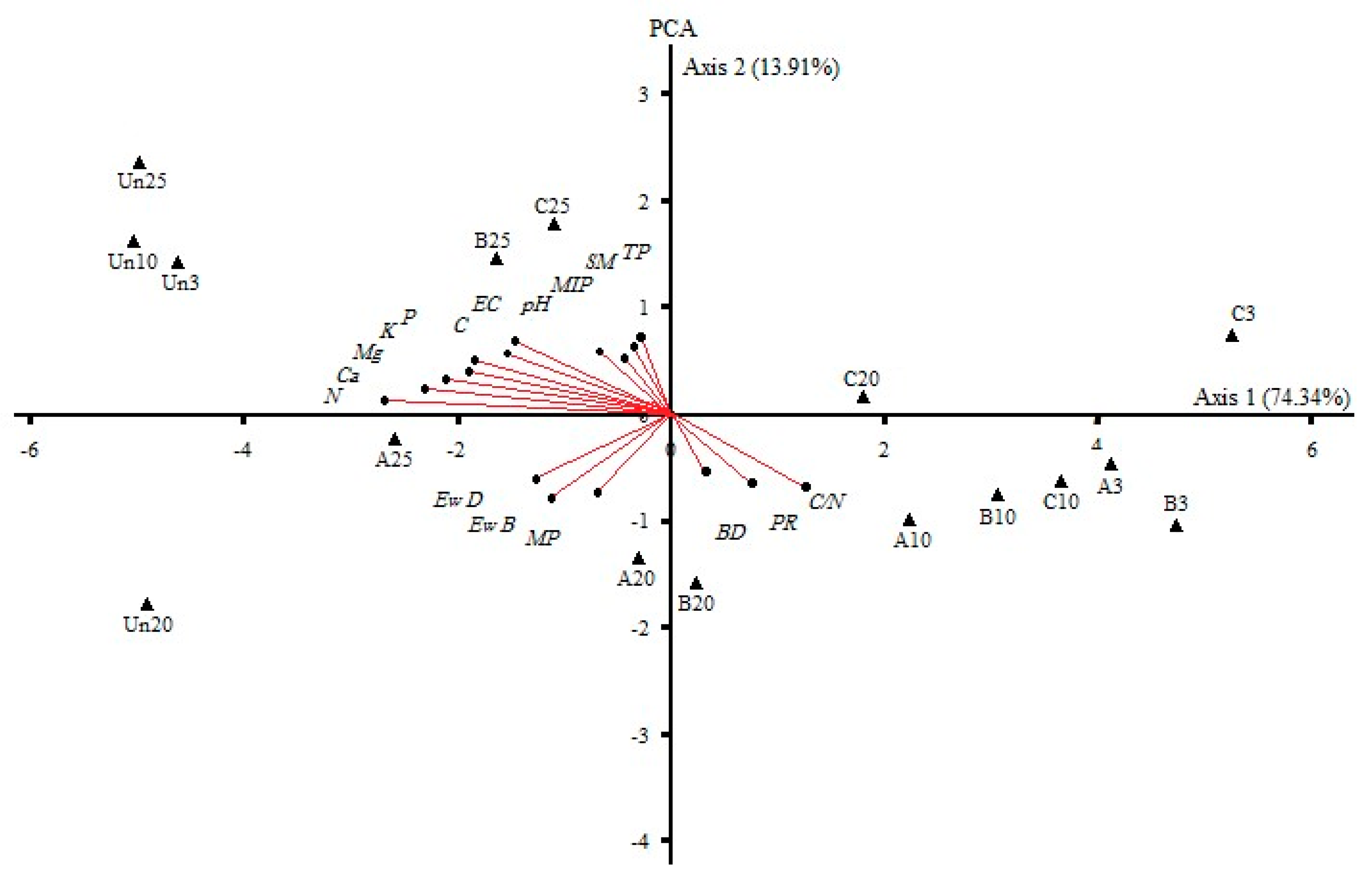
| Age of Skid Trail (years) | Replication | District (No. of Compartments) | Skid Trail Length (m) | Skid Trail Density (m ha−1) | Elevation (m) | Soil Texture |
|---|---|---|---|---|---|---|
| 3 | 1st | Gorazbon (C. 315) | 850 | 78.6 | 1186 | Clay |
| 2nd | Gorazbon (C. 316) | 1000 | 71.3 | 1214 | Clay | |
| 3rd | Gorazbon (C. 316) | 900 | 71.3 | 1191 | Silty clay loam | |
| 10 | 1st | Gorazbon (C. 318) | 930 | 65.8 | 1186 | Clay loam |
| 2nd | Gorazbon (C. 317) | 1050 | 84.8 | 1200 | Silty clay loam | |
| 3rd | Gorazbon (C. 317) | 860 | 84.8 | 1090 | Clay loam | |
| 20 | 1st | Namkhaneh (C. 221) | 1000 | 53.8 | 1120 | Silt loam |
| 2nd | Namkhaneh (C. 220) | 985 | 51.3 | 1010 | Clay loam | |
| 3rd | Namkhaneh (C. 220) | 800 | 51.3 | 1117 | Clay | |
| 25 | 1st | Namkhaneh (C. 218) | 1040 | 74.5 | 1050 | Clay |
| 2nd | Namkhaneh (C. 218) | 980 | 74.5 | 1140 | Silty clay loam | |
| 3rd | Namkhaneh (C. 221) | 950 | 53.8 | 1020 | Clay |
| Source of Variance | Age of Skid Trail | Traffic Intensity | Slope | Wheel Track | Depth | Interaction | ||||||
|---|---|---|---|---|---|---|---|---|---|---|---|---|
| d.f. | p-Value | d.f. | p-Value | d.f. | p-Value | d.f. | p-Value | d.f. | p-Value | d.f. | p-Value | |
| BD (g cm−3) | 3 | 0.000 ** | 2 | 0.000 ** | 2 | 0.418 ns | 2 | 0.254 ns | 1 | 0.000 ** | 24 | 0.63 ns |
| PR (MPa) | 3 | 0.000 ** | 2 | 0.000 ** | 2 | 0.000 ** | 2 | 0.000 ** | 1 | 0.000 ** | 24 | 0.998 ns |
| TP (%) | 3 | 0.000 ** | 2 | 0.000 ** | 2 | 0.041 * | 2 | 0.224 ns | 1 | 0.005 ** | 24 | 0.993 ns |
| MP (%) | 3 | 0.000 ** | 2 | 0.546 ns | 2 | 0.305 ns | 2 | 0.350 ns | 1 | 0.000 ** | 24 | 0.998 ns |
| MIP (%) | 3 | 0.000 ** | 2 | 0.549 ns | 2 | 0.481 ns | 2 | 0.783 ns | 1 | 0.000 ** | 24 | 0.999 ns |
| SM (%) | 3 | 0.000 ** | 2 | 0.549 ns | 2 | 0.481 ns | 2 | 0.783 ns | 1 | 0.000 ** | 24 | 0.999 ns |
| Different Years After the Skidding Operation (Years) | |||||
|---|---|---|---|---|---|
| Soil Physical Properties | 3 | 10 | 20 | 25 | Un |
| BD (g cm−3) | 1.07 ± 0.01 a | 1.12 ± 0.01 b | 1.05 ± 0.01 a | 1.03 ± 0.01 a | 0.95 ± 0.03 c |
| PR (MPa) | 3.25 ± 0.06 a | 3.04 ± 0.04 b | 2.90 ± 0.04 b | 2.0 ± 0.04 c | 1.57 ± 0.12 d |
| TP (%) | 84.03 ± 0.23 b | 83.0 ± 0.15 c | 84.04 ± 0.15 b | 84.47 ± 0.15 ab | 86.16 ± 0.48 a |
| MP (%) | 51.23 ± 0.57 c | 52.66 ± 0.38 c | 53.14 ± 0.38 b | 55.36 ± 0.38 b | 66.78 ± 0.19 a |
| MIP (%) | 32.8 ± 0.63 a | 30.34 ± 0.42 a | 30.9 ± 0.42 b | 29.11 ± 0.42 b | 19.38 ± 1.3 c |
| SM (%) | 40.2 ± 1.24 c | 41.2 ± 0.82 b | 41.76 ± 0.82 b | 42.73 ± 0.82 b | 44.78 ± 2.58 a |
| Source of Variance | Age of Skid Trail | Traffic Intensity | Slope | Wheel Track | Depth | Interaction | ||||||
|---|---|---|---|---|---|---|---|---|---|---|---|---|
| d.f. | p-Value | d.f. | p-Value | d.f. | p-Value | d.f. | p-Value | d.f. | p-Value | d.f. | p-Value | |
| pH (1:2.5 H2O) | 3 | 0.000 ** | 2 | 0.000 ** | 2 | 0.000 ** | 2 | 0.000 ** | 1 | 0.000 ** | 24 | 0.690 ns |
| EC (ds/m) | 3 | 0.000 ** | 2 | 0.000 ** | 2 | 0.000 ** | 2 | 0.000 ** | 1 | 0.000 ** | 24 | 0.000 ** |
| C (%) | 3 | 0.000 ** | 2 | 0.000 ** | 2 | 0.107 ns | 2 | 0.999 ns | 1 | 0.722 ns | 24 | 1.000 ns |
| N (%) | 3 | 0.000 ** | 2 | 0.000 ** | 2 | 0.000 ** | 2 | 0.361 ns | 1 | 0.000 ** | 24 | 1.000 ns |
| C/N ratio | 3 | 0.000 ** | 2 | 0.000 ** | 2 | 0.000 ** | 2 | 0.302 ns | 1 | 0.000 ** | 24 | 0.035 * |
| Available P (mg kg−1) | 3 | 0.000 ** | 2 | 0.000 ** | 2 | 0.000 ** | 2 | 0.513 ns | 1 | 0.006 ** | 24 | 1.000 ns |
| Available K (mg kg−1) | 3 | 0.000 ** | 2 | 0.000 ** | 2 | 0.000 ** | 2 | 0.694 ns | 1 | 0.020 * | 24 | 1.000 ns |
| Available Ca (mg kg−1) | 3 | 0.000 ** | 2 | 0.000 ** | 2 | 0.000 ** | 2 | 0.256 ns | 1 | 0.000 ** | 24 | 1.000 ns |
| Available Mg (mg kg−1) | 3 | 0.000 ** | 2 | 0.000 ** | 2 | 0.001 ** | 2 | 0.813 ns | 1 | 0.050 * | 24 | 1.000 ns |
| Earthworm density (n m−2) | 3 | 0.199 ns | 2 | 0.422 ns | 2 | 0.090 ns | 2 | 0.001 ** | 1 | 0.019 * | 24 | 0.652 ns |
| Earthworm biomass (mg m−2) | 3 | 0.215 ns | 2 | 0.429 ns | 2 | 0.115 ns | 2 | 0.002 ** | 1 | 0.030 * | 24 | 0.687 ns |
| Different Years after the Skidding Operation (Years) | |||||
|---|---|---|---|---|---|
| Soil Chemical and Biological Properties | 3 | 10 | 20 | 25 | Un |
| pH (1:2.5 H2O) | 5.96 ± 0.04 c | 6.07 ± 0.04 c | 6.32 ± 0.04 b | 6.59 ± 0.04 b | 7.04 ± 0.07 a |
| EC (ds/m) | 0.26 ± 0.19 c | 0.26 ± 0.19 c | 0.29 ± 0.19 b | 0.32 ± 0.19 b | 0.4 ± 0.35 a |
| C (%) | 2.31 ± 0.05 d | 2.78 ± 0.05 c | 2.9 ± 0.05 c | 3.12 ± 0.05 b | 4.04 ± 0.09 a |
| N (%) | 0.2 ± 0.05 d | 0.27 ± 0.05 c | 0.36 ± 0.05 b | 0.41 ± 0.05 b | 0.67 ± 0.01 a |
| C/N ratio | 11.55 ± 0.07 a | 10.29 ± 0.07 b | 8.05 ± 0.07 c | 7.61 ± 0.07 d | 6.03 ± 0.13 d |
| Available P (mg kg−1) | 9.59 ± 0.05 d | 12.01 ± 0.05 c | 14.49 ± 0.05 bc | 17.11 ± 0.05 b | 19.28 ± 0.09 a |
| Available K (mg kg−1) | 138.1 ± 1.08 d | 187.8 ± 1.08 cd | 238.4 ± 1.08 c | 275.7 ± 1.08 b | 321.49 ± 2.03 a |
| Available Ca (mg kg−1) | 105.7 ± 0.39 d | 137.1 ± 0.39 c | 176.6 ± 0.39 c | 214.3 ± 0.39 b | 239.05 ± 0.75 a |
| Available Mg (mg kg−1) | 28.85 ± 0.23 d | 37.23 ± 0.23 c | 44.27 ± 0.23 bc | 51.94 ± 0.23 b | 61.18 ± 0.43 a |
| Earthworm density (n m−2) | 0.22 ± 0.07 d | 0.33 ± 0.07 c | 0.41 ± 0.07 b | 0.48 ± 0.07 b | 0.67 ± 0.14 a |
| Earthworm biomass (mg m−2) | 0.94 ± 0.31 d | 1.41 ± 0.31 c | 1.71 ± 0.31 bc | 2.05 ± 0.31 b | 2.95 ± 0.59 a |
| Variable | Traffic Intensity | Slope Classes | |||
|---|---|---|---|---|---|
| Pearson Correlation (R) | p-Value | Pearson Correlation (R) | p-Value | ||
| Soil physical properties | BD | 0.92 ** | 0.000 | 0.83 ** | 0.000 |
| PR | 0.95 ** | 0.000 | 0.93 ** | 0.000 | |
| TP | –0.76 ** | 0.000 | –0.91 ** | 0.000 | |
| MP | –0.52 * | 0.021 | –0.99 ** | 0.000 | |
| MIP | –0.51 * | 0.015 | –0.58 * | 0.020 | |
| SM | –0.52 * | 0.015 | –0.58 * | 0.020 | |
| Soil chemical properties | pH | –0.98 ** | 0.000 | –0.98 ** | 0.000 |
| EC | –0.94 ** | 0.000 | –0.95 ** | 0.000 | |
| C | –0.97 ** | 0.000 | –0.98 ** | 0.000 | |
| N | –0.98 ** | 0.000 | –0.98 ** | 0.000 | |
| C/N | 0.84 ** | 0.000 | 0.67 ** | 0.000 | |
| Available P | –0.98 ** | 0.000 | –0.98 ** | 0.000 | |
| Available K | –0.98 ** | 0.000 | –0.98 ** | 0.000 | |
| Available Ca | –0.98 ** | 0.000 | –0.97 ** | 0.000 | |
| Available Mg | –0.99 ** | 0.000 | –0.98 ** | 0.000 | |
| Soil biological properties | Ew D | –0.96 ** | 0.000 | –0.88 ** | 0.000 |
| Ew B | –0.96 ** | 0.000 | –0.90 ** | 0.000 | |
© 2020 by the authors. Licensee MDPI, Basel, Switzerland. This article is an open access article distributed under the terms and conditions of the Creative Commons Attribution (CC BY) license (http://creativecommons.org/licenses/by/4.0/).
Share and Cite
Sohrabi, H.; Jourgholami, M.; Jafari, M.; Shabanian, N.; Venanzi, R.; Tavankar, F.; Picchio, R. Soil Recovery Assessment after Timber Harvesting Based on the Sustainable Forest Operation (SFO) Perspective in Iranian Temperate Forests. Sustainability 2020, 12, 2874. https://doi.org/10.3390/su12072874
Sohrabi H, Jourgholami M, Jafari M, Shabanian N, Venanzi R, Tavankar F, Picchio R. Soil Recovery Assessment after Timber Harvesting Based on the Sustainable Forest Operation (SFO) Perspective in Iranian Temperate Forests. Sustainability. 2020; 12(7):2874. https://doi.org/10.3390/su12072874
Chicago/Turabian StyleSohrabi, Hadi, Meghdad Jourgholami, Mohammad Jafari, Naghi Shabanian, Rachele Venanzi, Farzam Tavankar, and Rodolfo Picchio. 2020. "Soil Recovery Assessment after Timber Harvesting Based on the Sustainable Forest Operation (SFO) Perspective in Iranian Temperate Forests" Sustainability 12, no. 7: 2874. https://doi.org/10.3390/su12072874
APA StyleSohrabi, H., Jourgholami, M., Jafari, M., Shabanian, N., Venanzi, R., Tavankar, F., & Picchio, R. (2020). Soil Recovery Assessment after Timber Harvesting Based on the Sustainable Forest Operation (SFO) Perspective in Iranian Temperate Forests. Sustainability, 12(7), 2874. https://doi.org/10.3390/su12072874








